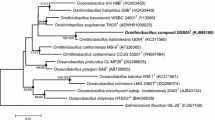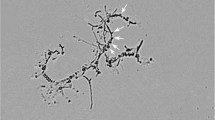Abstract
A polyphasic taxonomic approach was used to characterize a presumptively novel diazotrophic bacterium, designated strain CC-YTH430T, isolated from a compost sample in Taiwan. Cells of strain CC-YTH430T were found to be Gram-stain negative, facultative anaerobic rods that formed yellow-colored colonies on nutrient agar. Cell growth occurred at 15–40 °C, pH 5.0–9.0 and in the presence of 0–2% NaCl. Strain CC-YTH430T resembled Mesorhizobium species while sharing high pair-wise 16S rRNA gene sequence similarities with Mesorhizobium silamurunense, Mesorhizobium thiogangeticum, Mesorhizobium plurifarium, Mesorhizobium tamadayense, Mesorhizobium amorphae (96.9% each), Mesorhizobium sediminum (96.8%), and Mesorhizobium soli (96.5%) and < 96.5% similarity to other species. Strain CC-YTH430T showed 78.8–79.7% average nucleotide identity compared to the type strains of M. amorphae, M. plurifarium, M. soli, M. tamadayense and M. wenxiniae. The N2-fixing activity of strain CC-YTH430T was 0.2 nmol ethylene h−1 at 30 °C. The respiratory system was ubiquinone 10 (Q-10) and the DNA G+C content was 62.0 ± 0.2 mol%. The major fatty acids (> 5%) were C16:0, C17:0 cyclo, C19:0 cyclo ω8c, C14:0 3OH/C16:1 iso I and C18:1ω7c/C18:1ω6c. The polar lipid profile contained diphosphatidylglycerol, phosphatidylglycerol, phosphatidylcholine, phosphatidylmonomethylethanolamine and an unidentified aminolipid in major amounts. In addition, phosphatidylethanolamine, an unidentified lipid and several unidentified polar lipids were also found in moderate-to-trace amounts. Based on the phylogenetic, phenotypic and chemotaxonomic features, strain CC-YTH430T is proposed to represent a novel Mesorhizobium species, for which the name Mesorhizobium composti sp. nov. (type strain CC-YTH430T = BCRC 81024T = JCM 31762T) is proposed.



Similar content being viewed by others
Abbreviations
- AL1–2:
-
Unidentified aminolipids
- ANI:
-
Average nucleotide identity
- APL:
-
Unidentified aminophospholipid
- BCRC:
-
Bioresource Collection and Research Center
- DPG:
-
Diphosphatidylglycerol
- DSMZ:
-
Deutsche Sammlung von Mikroorganismen und Zellkulturen
- FAME:
-
Fatty acid methyl esters
- FID:
-
Flame-ionization detector
- HPLC:
-
High-performance liquid chromatography
- JCM:
-
Japan Collection of Microorganisms
- KCTC:
-
Korean Collection for Type Cultures
- L1:
-
Unidentified lipid
- MA:
-
Marine agar
- MIDI:
-
Microbial identification
- NA:
-
Nutrient agar
- NB:
-
Nutrient broth
- PC:
-
Phosphatidylcholine
- PE:
-
Phosphatidylethanolamine
- PG:
-
Phosphatidylglycerol
- PL1–6:
-
Unidentified phospholipids
- PME:
-
Phosphatidylmonomethylethanolamine
- tr:
-
Trace
- TSA:
-
Tryptic soy agar
- YMA:
-
Yeast extract mannitol agar
References
Bankevich A, Nurk S, Antipov D, Gurevich AA, Dvorkin M, Kulikov AS, Lesin VM, Nikoleko SI, Pham S, Prjibelski AD, Pyshkin AV, Sirotkin AV, Vyahhi N, Tesler G, Alekseyev MA, Pevzner PA (2012) SPAdes: a new genome assembly algorithm and its applications to single-cell sequencing. J Comput Biol 19:455–477
Bernardet JF, Nakagawa Y, Holmes B (2002) Proposed minimal standards for describing new taxa of the family Flavobacteriaceae and emended description of the family. Int J Syst Evol Microbiol 52:1049–1070
Chen WX, Wang ET, Kuykendall LD (2005) Genus VI. Mesorhizobium Jarvis, van Berkum, Chen, Nour, Fernandez, Cleyet-Marel and Gillis 1997, 897VP. In: Brenner DJ, Krieg NR, Staley JT, Garrity GM (eds) Bergey’s manual of systematic bacteriology, vol 2, part C, 2nd edn. Springer, New York, pp 403–408
Chun J, Oren A, Ventosa A, Christensen H, Arahal DR, da Costa MS, Rooney AP, Yi H, Xu XW, Meyer SD, Trujillo ME (2018) Proposed minimal standards for the use of genome data for the taxonomy of prokaryotes. Int J Syst Evol Microbiol 68:461–466
Clarke PH, Cowan ST (1952) Biochemical methods for bacteriology. J Gen Microbiol 6:187
Collins MD (1985) Isoprenoid quinone analysis in classification and identification. In: Goodfellow M, Minnikin DE (eds) Chemical methods in bacterial systematics. Academic Press, London, pp 267–287
de Lajudie P, Willems A, Nick G, Moreira F, Molouba F, Hoste B, Torck U, Neyra M, Collins MD, Lindstrőm K, Dreyfus B, Gillis M (1998) Characterization of tropical tree rhizobia and description of Mesorhizobium plurifarium sp. nov. Int J Syst Bacteriol 48:369–382
Felsenstein J (1981) Evolutionary trees from DNA sequences: a maximum likelihood approach. J Mol Evol 17:368–376
Felsenstein J (1985) Confidence limits on phylogenies: an approach using the bootstrap. Evolution 39:783–791
Fitch WM (1971) Toward defining the course of evolution: minimum change for a specific tree topology. Syst Zool 20:406–416
Gaunt MW, Turner SL, Rigottier-Gois L, Lloyd-Macgilp SA, Young JPW (2001) Phylogenies of atpD and recA support the small subunit rRNA-based classification of rhizobia. Int J Syst Evol Microbiol 51:2037–2048
Ghosh W, Roy P (2006) Mesorhizobium thiogangeticum sp. nov., a novel sulfur-oxidizing chemolithoautotroph from rhizosphere soil of an Indian tropical leguminous plant. Int J Syst Evol Microbiol 56:91–97
Hameed A, Shahina M, Lai WA, Lin SY, Young LS, Liu YC, Hsu YH, Young CC (2015) Oricola cellulosilytica gen. nov., sp nov., a cellulose-degrading bacterium of the family Phyllobacteriaceae isolated from surface seashore water, and emended descriptions of Mesorhizobium loti and Phyllobacterium myrsinacearum. Antonie Van Leeuwenhoek 107:759–771
Hardy R, Burns RC, Holsten RD (1973) Application of the acetylene–ethylene assay for measurement of nitrogen fixation. Soil Biol Biochem 5:47–81
Heiner CR, Hunkapiller LK, Chen SM, Glass JI, Chen EY (1998) Sequencing multimegabase-template DNA using BigDye terminator chemistry. Genome Res 8:557–561
Jarvis BDW, Pankhurst CE, Patel JJ (1982) Rhizobiurn loti, a new species of legume root nodule bacteria. Int J Syst Bacteriol 32:378–380
Jarvis BDW, Van Berkum P, Chen WX, Nour SM, Fernandez MP, Cleyet-Marel JC, Gillis M (1997) Transfer of Rhizobium loti, Rhizobium huakuii, Rhizobium ciceri, Rhizobium mediterraneum, and Rhizobium tianshanense to Mesorhizobium gen. nov. Int J Syst Bacteriol 47:895–898
Jukes TH, Cantor CR (1969) Evolution of protein molecules. In: Munro HN (ed) Mammalian protein metabolism. Academic Press, New York, pp 21–32
Koch B, Evans HJ (1966) Reduction of acetylene to ethylene by soybean root nodules. Plant Physiol 41:1748–1750
Kuklinsky-Sobral J, Araujo WL, Mendes R, Geraldi IO, Pizzirani-Kleiner AA, Azevedo JL (2004) Isolation and characterization of soybean-associated bacteria and their potential for plant growth promotion. Environ Microbiol 6:1244–1251
Laguerre G, Nour SM, Macheret V, Sanjuan J, Drouin P, Amarger N (2001) Classification of rhizobia based on nodC and nifH gene analysis reveals a close phylogenetic relationship among Phaseolus vulgaris symbionts. Microbiology 147:981–993
Laranjo M, Alexandre A, Oliveira S (2014) Legume growthpromoting rhizobia: an overview on the Mesorhizobium genus. Microbiol Res 169:2–17
Lee I, Ouk Kim Y, Park SC, Chun J (2016) OrthoANI: an improved algorithm and software for calculating average nucleotide identity. Int J Syst Evol Microbiol 66:1100–1103
Marcos-García M, Menéndez E, Ramírez-Bahena MH, Mateos PF, Peix Á, Velazquez E, Rivas R (2017) Mesorhizobium helmanticense sp. nov., isolated from Lotus corniculatus nodules. Int J Syst Evol Microbiol 67:2301–2305
Mesbah M, Premachandran U, Whitman WB (1989) Precise measurement of the G+C content of deoxyribonucleic acid by high performance liquid chromatography. Int J Syst Bacteriol 39:159–167
Meyer SED, Tan HW, Andrews M, Heenan PB, Willems A (2016) Mesorhizobium calcicola sp. nov., Mesorhizobium waitakense sp. nov., Mesorhizobium sophorae sp. nov., Mesorhizobium newzealandense sp. nov. and Mesorhizobium kowhaii sp. nov. isolated from Sophora root nodules. Int J Syst Evol Microbiol 66:786–795
Miller LT (1982) Single derivatization method for routine analysis of bacterial whole-cell fatty acid methyl esters, including hydroxyl acids. J Clin Microbiol 16:584–586
Minnikin DE, O’Donnell AG, Goodfellow M, Alderson G, Athalye M et al (1984) An integrated procedure for the extraction of bacterial isoprenoid quinones and polar lipids. J Microbiol Methods 2:233–241
Murray RGE, Doetsch RN, Robinow CF (1994) Determination and cytological light microscopy. In: Gerhardt P, Murray RGE, Wood WA, Krieg NR (eds) Methods for general and molecular bacteriology. American Society for Microbiology, Washington, pp 32–34
Paisley R (1996) MIS whole cell fatty acid analysis by gas chromatography training manual. MIDI, Newark
Poly F, Monrozier LJ, Bally R (2001) Improvement in the RFLP procedure for studying the diversity of nifH genes in communities of nitrogen fixers in soil. Res Microbiol 152:95–103
Ramírez-Bahena MH, Hernández M, Peix Á, Velázquez E, León-Barrios M (2012) Mesorhizobial strains nodulating Anagyris latifolia and Lotus berthelotii in Tamadaya ravine (Tenerife, Canary Islands) are two symbiovars of the same species, Mesorhizobium tamadayense sp. nov. Syst Appl Microbiol 35:334–341
Richter M, Rosselló-Móra R (2009) Shifting the genomic gold standard for the prokaryotic species definition. Proc Natl Acad Sci USA 106:19126–19131
Saitou N, Nei M (1987) The neighbor-joining method: a new method for reconstructing phylogenetic trees. Mol Biol Evol 4:406–425
Sarita S, Sharma PK, Priefer UB, Prell J (2005) Direct amplification of rhizobial nodC sequences from soil total DNA and comparison to nodC diversity of root nodule isolates. FEMS Microbiol Ecol 54:1–11
Sasser M (1990) Identification of bacteria by gas chromatography of cellular fatty acids, MIDI technical note 101. MIDI Inc, Newark
Stackebrandt E, Goebel BM (1994) Taxonomic note: a place for DNA-DNA reassociation and 16S rRNA sequence analysis in the present species definition in bacteriology. Int J Syst Bacteriol 44:846–849
Tamura K, Stecher G, Peterson D, Filipski A, Kumar S (2013) MEGA6: molecular evolutionary genetics analysis version 6.0. Mol Biol Evol 30:2725–2729
Thompson JD, Gibson TJ, Plewniak F, Jeanmougin F, Higgins DG (1997) The CLUSTAL_X windows interface: flexible strategies for multiple sequence alignment aided by quality analysis tools. Nucleic Acids Res 25:4876–4882
Vincent JM (1970a) A manual for the practical study of root-nodule bacteria. Blackwell Scientific, Oxford
Vincent JM (1970b) The cultivation, isolation and maintenance of rhizobia. In: Vincent JM (ed) A manual for the practical study of the root-nodule bacteria. Blackwell Scientific, Oxford, pp 1–13
Xie CH, Yokota A (2004) Phylogenetic analyses of the nitrogen-fixing genus Derxia. J Gen Appl Microbiol 50:129–135
Yoon SH, Ha SM, Kwon S, Lim J, Kim Y, Seo H, Chun J (2017) Introducing EzBioCloud: a taxonomically united database of 16S rRNA and whole genome assemblies. Int J Syst Evol Microbiol 67:1613–1617
Yuan CG, Jiang Z, Xizo M, Zhou EM, Kim CJ, Hozzein WN, Park DJ, Zhi XY, Li WJ (2016) Mesorhizobium sediminum sp. nov., isolated from deep-sea sediment. Int J Syst Evol Microbiol 11:4797–4802
Zehr JP, McReynolds LA (1989) Use of degenerate oligonucleotides for amplification of the nifH gene from the marine cyanobacterium Trichodesmium thiebautii. Appl Environ Microbiol 55:2522–2526
Zehr JP, Jenkins BD, Short SM, Steward GF (2003) Nitrogenase gene diversity and microbial community structure: a crosssystem comparison. Environ Microbiol 5:539–554
Zhao CT, Wang ET, Zhang YM, Chen WF, Sui XH, Chen WX, Liu HC, Zhang XX (2012) Mesorhizobium silamurunense sp. nov., isolated from root nodules of Astragalus species. Int J Syst Evol Microbiol 62:21803–22186
Zhou J, Fries MR, Chee-Sanford JC, Tiedje JM (1995) Phylogenetic analyses of a new group of denitrifiers capable of anaerobic growth of toluene and description of Azoarcus tolulyticus sp. nov. Int J Syst Bacteriol 45:500–506
Acknowledgements
This work was financially supported by the Ministry of Science and Technology (Taiwan) under Grant No. MOST 107-2634-F-005-002 and by the “Innovation and Development Center of Sustainable Agriculture” from The Featured Areas Research Center Program within the framework of the Higher Education Sprout Project by the Ministry of Education (MOE) in Taiwan.
Author information
Authors and Affiliations
Contributions
SYL analyzed most of the data and wrote the manuscript. AH contributed to providing critical revisions to this article. YTH was responsible for collecting samples and isolating the novel microorganism. All authors discussed the results and revised the manuscript.
Corresponding author
Ethics declarations
Conflict of interest
The authors declare that they have no conflict of interest.
Additional information
Publisher's Note
Springer Nature remains neutral with regard to jurisdictional claims in published maps and institutional affiliations.
The GenBank/EMBL/DDBJ accession numbers for the 16S rRNA, atpD, recA gene sequences and the draft genome of Mesorhizobium composti strain CC-YTH430T are KX988315, MG708501, MG708502 and SSNY00000000, respectively.
Electronic supplementary material
Below is the link to the electronic supplementary material.
Rights and permissions
About this article
Cite this article
Lin, SY., Hameed, A., Hsieh, YT. et al. Mesorhizobium composti sp. nov., isolated from compost. Antonie van Leeuwenhoek 112, 1387–1398 (2019). https://doi.org/10.1007/s10482-019-01270-y
Received:
Accepted:
Published:
Issue Date:
DOI: https://doi.org/10.1007/s10482-019-01270-y




